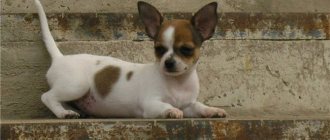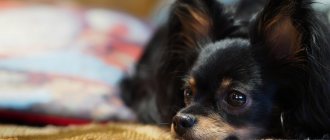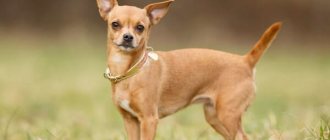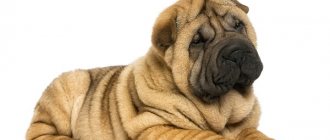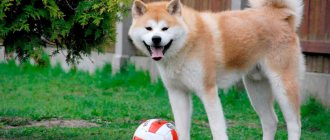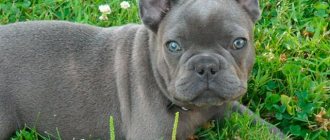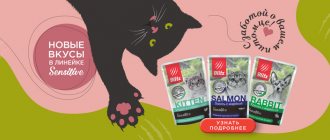Author of the article: Dmitry Boyko | Updated: 12-09-2020
No other breed has such a wealth of colors as the Chihuahua! Among them there are both more or less common and quite rare. There is only one “banned” one. According to the breed standard, Chihuahuas are allowed one-color or two-color colors, as well as tricolor. Each color must correspond to certain colors of the nose and eyes. Most colors can be either long-haired or smooth-haired.
How do you get the desired color when crossing?
First of all, you need to thoroughly study the pedigree of both partners in order to understand which pigment is dominant in the dog’s ancestors. To correctly predict the color of the future offspring, you need to take into account the color of the parents’ fur coat:
- For example, if mom and dad are chocolate, then the puppies are likely to be red or black. But not gray.
- And if future parents have sable or cream fur, then they almost always give birth to sable or cream puppies, respectively.
- Brown pets give birth to brown babies. You won't be able to get any coals. The same applies to red representatives of the breed.
- Gray or purple Chihuahuas give birth to yellow or sandy puppies.
- And red-haired pets always give birth to red-haired babies, because the “redness” gene is dominant.
There is another type of Chihuahua color called “merle,” or otherwise marbled. Marbled sneezes are native to America. Despite the unusual spotted appearance, "merle" is not recognized by the RKF (only in the case of Chihuahuas). And this is due to frequent health problems in such pets. For example, marbled sneezes often have problems with their eyes and hearing. And sometimes it even happened that marbled chihuahuas had no eyes or ears.
Breed standard and what purebred dogs look like
The international standard does not establish the parameters of the Chihuahua, but in 1954 the English Kennel Club developed indicators of weight, height, color, proportions and physique for the Chihuahua.
The name of the breed is given in honor of the Mexican state where the dog was discovered.
Chihuahua is the smallest breed in the world.
She is distinguished by her aristocratic behavior, she always walks with her head raised, her tail is slightly curled towards the lower back. It creates a semi-ring over the back.
The length of an adult dog should be a couple of centimeters less than the height at the withers..
An ideal representative of the breed should have a square body, height 30-38 cm, weight 1.5-4 kg.
The smallest representatives of Chihuahuas can weigh 500 g-1.5 kg:
- The dog's eyes should be round and protruding. A light iris is not an indicator of purebredness, only a dark one.
- The Chihuahua has large ears, wide at the base and tapering to the tip. In a calm state, they can fall, as they cease to be tense.
- An adult dog should have 12 incisors, 4 canines, 16 premolars, 10 molars, for a total of 42 teeth. An overshot or misaligned jaw is a defect.
- The chest should be broad but in proportion to the body, and the ribs should be rounded, not barrel-shaped. A healthy dog looks slim, but not too thin - the body should be athletic. The back is muscular, the croup is strong.
- The head should resemble an apple in shape. The Chihuahua is the only breed in which the fontanel does not overgrow. The dog's forehead is high, with prominent eyebrows. The cheekbones are rounded, the muzzle is short, the lips should completely cover the teeth. The nose is slightly snub, there is a crease between the eyes. Lips and cheeks are dry.
- The hind legs are developed slightly larger than the front ones - this is necessary for running and jumping. In general, all limbs are strong, designed for the dog to move freely. The gait is soft and active.
Popular Chihuahua colors
Further in the article there are various colors of Chihuahuas and their names. All the following colors are approved by the National Club of the Breed. In addition, the colors are approved by the RKF - Russian Cynological Federation. This means that each of the following colors is recognized as a standard.
Ginger
The natural red coat color of Chihuahuas is practically never found as an independent color. Most often, red and white Chihuahuas are born. A snow-white tint is present in the chest, limbs and tail. Other varieties of red include red-black and red-brown. Red itself often appears in a lighter or more intense degree.
White
As with the red sneeze, a completely white dog is a huge rarity. Contrasting colors like the white and black Chihuahua are more common. The blue and white sneeze looks more gentle.
Cream
Chihuahua cream color can be either pale, like ivory, or can turn into a more saturated beige. Pure cream sneeze is valued among breeders because it looks aristocratic and gentle.
Beige
In fact, beige is the same cream, but more pronounced and deep. That is, the difference is only in shades. Such subtleties are sometimes difficult to recognize.
Grey
Gray Chihuahuas often have white chests and toes. It is easy to confuse gray sneezes with blue ones, because at first glance the latter also give the impression of a gray fur coat.
Black
Again, black Chihuahuas without impurities are born very rarely. Additional color is often located on the chest, muzzle, limbs and tip of the tail. Common combinations with black are:
- Black and white. The first always acts as the main one, that is, it covers most of the Chihuahua’s body. This “cow” color on a Chihuahua looks funny. In addition, the black and white sneeze is considered a classic.
- Black and red. This black and tan color looks impressive, especially when there is a third shade on the coat - milky. As a rule, it appears as spots on the chest.
- Black and brown.
Brown (chocolate)
Brown and chocolate are slightly different things. The chocolate Chihuahua's fur has a reddish tint and overall the coloring looks deeper. Often the chocolate sneeze has white spots on the chest and limbs. There are chocolate and tan Chihuahuas with admixtures of other colors besides white.
A little bit about everything
Basically, when you buy a Chihuahua, they won't cause you any particular trouble in the future. These energetic spinners tend to get tired quickly and then become quiet and calm. At such moments, like happy cats after lively active games, they hide under some kind of blanket and fall asleep, showering you with cute snoring.
The culprit for such immodest breathing in a dream is the unusual structure of the skull. It has a sharp transition from the muzzle to the forehead.
Unpretentious and neat dogs are perfect for small apartments. They eat quite little - on average 50-80 grams of food per kilogram of the animal’s total weight per day.
They prefer shorter walks over longer ones, and they can go to the toilet in a regular cat litter box at home, if trained, of course.
Their fur does not have a strong specific odor. Overall, an excellent pet for people who prefer a moderate lifestyle.
Rare colors of Chihuahua
Sable
The sable color is characterized by a “coal” coating at the end of the hairs. Chihuahua sable can be pure, that is, without impurities. For example, a red sable chihuahua has red hairs and black hairs at the ends; a choco sable chihuahua has chocolate wool coated at the tips.
Tricolor
Tri-colored short-haired Chihuahuas have white as their base color. And the two additional ones are different - brown and black, red and black, blue and purple, and so on.
Pale yellow
This Chihuahua coloration means a light yellow coat color, often with a pink tint. Fawn happens:
- pure, that is, completely free of impurities;
- in combination with blue. This type is characterized by a blue tint.
- in combination with snow-white.
Isabella
A very rare type of Chihuahua. Isabella is an unusual shade that combines pink and gray. May be pale or more saturated. But these chihuahuas do not contain dark pigment.
Blue
At first glance, blue will not seem blue at all, but rather grayish-silver. The blue and tan coloring shows its beauty in the sun when the fur shimmers. The blue-fawn Chihuahua is considered an expensive representative of the breed.
Spotted
The spotted sneezeweed has two different colors on its coat. For example, black and white, black and gold, brown and white, etc. In this case, one of the colors is basic, that is, it takes up more space than the second. But there is also an even distribution of both shades. The spotted color is also called two-tone.
Sand
The sand color resembles a mixture of yellow and beige. Sometimes it is not easy to recognize a sandy one with the naked eye. It is often confused with its closest shades.
brindle
Chihuahuas with brindle coloring are rare. All over their fur there are symmetrical stripes, like a tiger. It should be noted that tiger sneezes cost more than single-color ones. If we talk about colors, they are different. But the stripes are most often darker than the base shade of the dog's body. The stripes are usually distributed evenly throughout the body, including the limbs and head. But sometimes they are more noticeable only on the back.
Pink
This is the name of a delicate orange shade that appears pink in certain lighting. In essence, this type is similar to peach.
Sometimes you can find artificially colored Chihuahuas, whose owners specially purchase pink dye for their fur. However, such an act will most likely lead to poisoning and death of the pet. Show business stars sometimes get carried away with this, which is why they later face condemnation from society.
Red
This color is a very rich and deep red. The red tint is especially noticeable when the sun hits the fur.
By the way, sometimes dogs' fur begins to turn red due to eating foods rich in iodine. But sometimes redness of the coat signals health problems.
Peach
This is a pink-orange shade that is considered a type of red color. Such a four-legged “peach” will also shimmer in the sun.
Lilac
The lilac color looks great on long-haired pets. There can be any shade - from light to dark. In addition to this, lilac dogs often have white spots on the chest and legs.
Character and temperament
This dog is temperamental, cheerful, and resistant to stress if the owner is nearby. They have a quick reaction, and the dogs are also very hardy.
Their small size does not prevent them from being brave and fearless; Chihuahuas will defend their owner without hesitation.
Representatives of this breed are active, they are funny, not lazy, and they are energetic.
They are reserved towards strangers, very curious about new objects and unusual processes occurring in the house.
CAREFULLY!
Chihuahuas love to follow their owners and get underfoot, so you need to be careful not to step on the dog or trip over it.
These are also clean dogs, they wash themselves, and quickly get used to the tray or diaper. But extreme stress can cause them to urinate uncontrollably.
Common colors in long-haired Chihuahuas
In fact, the length of the coat does not affect the frequency of appearance of a particular color in a Chihuahua. The only thing is that some colors look more impressive on long wool. Especially if you give your pet a model haircut at a grooming salon. The most common types of coloring are red with impurities, classic black and white, brown and beige-colored coats (including cream).
It should also be noted that as Chihuahuas grow older, the color saturation changes. This happens before the baby turns one year old. This is due to the fact that the pigment does not appear immediately at birth, but after some time. Saturation can go either upward or vice versa, and it is almost impossible to predict this. Changes in adult sneezes are observed less frequently, but are also possible. But they will no longer be associated with the distribution of the emerging pigment, but for other reasons. Among them are diseases of the central nervous system, internal organs, or even a simple change of food.
Brief history of origin
It is still not known for certain how exactly the Chihuahua breed appeared. It is only confirmed that it is of natural origin.
Most researchers agree that Chihuahuas originated in what is now Mexico. This is evidenced by wall paintings and excavation results.
The dogs were originally mute, they were called “techichi”. These were sacred animals that lived in the Taltec tribe.
There are also theories that they came from the Incas and Mayans.
One way or another, it was the Techichi that were the ancestors of modern Chihuahuas.
Rules of care
Chihuahuas, like any other breed, need proper care.
To make your pet feel comfortable, provide him with the following items::
- A place to sleep - it can be a bed or a house. Place it away from drafts and heating devices.
- Bowls - there should be two of them. For food and feed separately. It is optimal if they are made of stainless steel.
- Litter – Chihuahuas need a special litter box for dogs or absorbent diapers. He should stand apart from the trays of other pets.
- Comb and brush for grooming.
- Small rubber toys that your dog can use to occupy himself in your absence.
- Clothes and shoes for the cold season.
Hygiene procedures
Chihuahuas have quite sensitive and delicate skin, so you need to wash your pet no more than 3-4 times a year with a specialized shampoo for dogs.
CAREFULLY!
Avoid getting moisture into your ears. Before swimming, cover your ears with a cotton swab.
Brush your pet's teeth weekly to remove plaque and tartar with a brush, or let him chew on special enamel cleaning sticks.
Due to the fact that Chihuahuas are rarely outdoors, the claws do not have time to wear down and grow back . Regularly trim excess length of claws with a nail clipper.
Feeding
You need to feed your Chihuahua regularly 2-3 times a day, preferably at the same time.
Dogs of this breed have an excellent appetite and are prone to overeating and gaining excess weight.
The diet should consist of balanced premium food intended for small breeds or natural products : lean meat, eggs, vegetables and fruits .
Also read about Purina Pro Plan Small & Mini Puppy food for Chihuahuas.
Upbringing
Raising a Chihuahua dog is a long and lengthy process.
The first and most important thing you must do is to define your leadership position, otherwise all further education will be in vain.
The entire training process should be based on incentives and rewards for correct behavior so that the dog is motivated to follow commands.
Basics of Science
Despite the fact that the color of Chihuahua puppies in the future litter cannot be known one hundred percent, this can be assumed based on some data. According to the basics of genetics, one pigment called “melanin” is responsible for the variety of shades in dogs. There are two forms of the chemical state of this pigment:
- eumelanin – responsible for the black or brown (chocolate) background of the animal’s fur;
- pheomelanin - responsible for the yellow or red background of the coat.
Alleles are different forms of the same gene. Alleles of several genes control future coloring. Genes are responsible for the appearance of a specific trait. They can interact with each other. Thanks to the resulting individual set of genes, the genotype of the dog is created. It is responsible for the formation of the animal’s phenotype – its appearance. We subsequently see it with the naked eye - this is the resulting shade of the dog’s coat.
List of genetic problems associated with the M gene
Breeds that have the mutation:
- dachshund;
- Great Dane;
- pug;
- French Bulldog;
- coolie;
- Australian Shepherd;
- long-haired and short-haired Scottish Shepherd;
- corgi cardigan;
- Border Collie;
- leopard dog.
Leopard Hound
When a breeder is not sure whether his pet is a merle, it is recommended to have a test done. Homozygous individuals (MM) are sometimes born:
- with deformity or complete absence of eyes or ears;
- partially or completely deaf (54.6% of MM-homozygotes and 36.8% of MM-heterozygotes were found with hearing problems of varying severity - from mild to complete deafness);
- barren;
- predisposed to eyeball abnormalities (flattened fundus, twilight blindness, risk of developing cataracts).
Important! Deafness has not been found in the Catahoula leopard dog, even in the homozygous system (MM).
Dominant homozygotes arise only from the combination of two individuals - carriers of the M gene. In many European countries, their mating has been banned.
Price range
The cost puppy depends on what class it belongs to :
- Show class . Exhibition copy, price varies depending on the title of the parents. From 50 to 200 thousand rubles.
- Breeding class . The most popular class of the breed. The price varies from 40 to 60 thousand rubles.
- Pet class . Dogs for the soul and for home keeping. They have no title or pedigree. The price varies from 10 to 20 thousand rubles.
Purple Chihuahua girls are more expensive than boys.
This is due to the possibility of obtaining further offspring.
